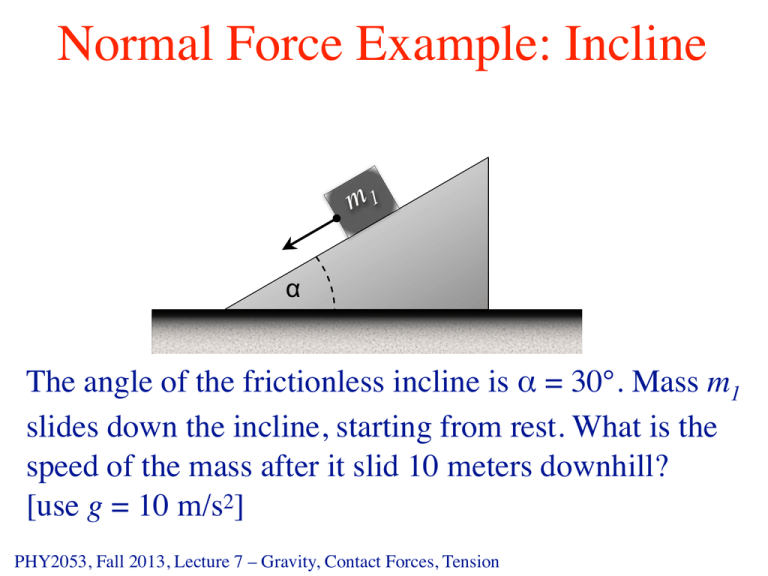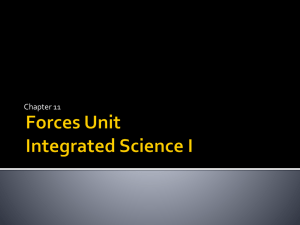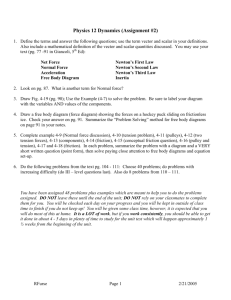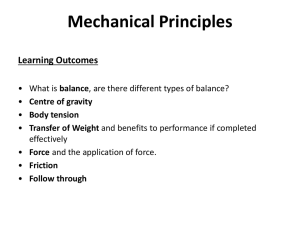Normal Force Example: Incline
advertisement

Normal Force Example: Incline m1 α The angle of the frictionless incline is α = 30°. Mass m1 slides down the incline, starting from rest. What is the speed of the mass after it slid 10 meters downhill? [use g = 10 m/s2] PHY2053, Fall 2013, Lecture 7 – Gravity, Contact Forces, Tension Newton’s Third Law LawIII: Lex III:Actioni To every contrariam action there semper is always et æqualem an equalesse and Law 3: Inreaction: ansive interaction objects, each reactionem: opposite corporum or the between forces duorum oftwo two actiones bodiesinon seeach object exerts a esse force onand the are other. Thesein two forces mutuoare other semper always equal æquales et in directed partes contrarias opposite are equal in magnitude and opposite in direction. dirigi. directions. m1 PHY2053, Fall 2013, Lecture 7 – Gravity, Contact Forces, Tension m2 Example: Two Blocks m1 m2 In the picture above, the two blocks are placed on a frictionless surface, in contact with each other. The masses of the two blocks are m1 = 10 kg and m2 = 15 kg. A force F1 = 100 N is being applied to mass m1 from the left, and force F2 = 200 N is being applied to mass m2 from the right. Compute the force F2,1 that mass m1 is exerting on mass m2. Contact Forces, Tension PHY2053, Fall 2013, Lecture 7 – Gravity, Gravitational force ● Newton’s Law of Gravitation: ● where m1 and m2 are the masses of the two bodies ● r is the distance between them, measured from the center of the (spherical) object ● G is the universal gravitational constant G = 6.674 × 10-11 N m2 / kg2 ● provides excellent description of planetary motion PHY2053, Fall 2013, Lecture 7 – Gravity, Contact Forces, Tension 4 Example: Cranial Attraction ● The heads of neighboring students in the classroom are separated by ~ 1 m. A typical human head weighs about 5 kg. Compute the attractive force (due to gravitation) between the heads of two students. m1 m2 F =G 2 r ● m1 = m2 = 5 kg, r = 1 m, G = 6.674 × 10-11 N m2/kg2 ● use in formula → obtain F = 1.67 × 10-9 N PHY2053, Fall 2013, Lecture 7 – Gravity, Contact Forces, Tension 5 Example: Weight change while airplane is in flight ● An airplane is cruising at the altitude of 10 km above sea level. What factor less does a passenger weigh at that altitude compared to their weight at sea level? The radius of the Earth is 6370 km and its mass is ME = 6 × 1024 kg. m1 m2 F =G 2 r ● m1 = ME, m2 = m (unknown) ● Compare F(r) for r = RE to F(r) for r = (RE + 10 km) PHY2053, Fall 2013, Lecture 7 – Gravity, Contact Forces, Tension 6 Example: “g” on surface of Mars m1 m2 F =G 2 r Declare this “g” when computed at the surface of a specific planet. Formula then simplifies to F = m2 g ● For all objects on the surface of a planet, one of the masses (mass of the planet) and r are the same ● formula can then be simplified to F = m g, except g is different on each planet (depends on M and R) ● for Mars, MMars = 1/9 ME , RMars = 0.533 RE ● we can then compute gMars in terms of gEarth PHY2053, Fall 2013, Lecture 7 – Gravity, Contact Forces, Tension 7 Tension Force ● “Ideal String” concept: ● massless, infinitely thin, fixed length ● withstands any force without breaking “String with tension T” m1 PHY2053, Fall 2013, Lecture 7 – Gravity, Contact Forces, Tension m2 Tension Example: Pulley + Weights The masses in the depicted Atwood machine are m1 = 5 kg and m2 = 3 kg. ● What is the acceleration of mass m1? ● What is the tension T2 of the cable holding the massless pulley? PHY2053, Fall 2013, Lecture 7 – Gravity, Contact Forces, Tension T2 m1 m2 Friction ● Force due to imperfections of surfaces in contact ● For a pair of surfaces, the frictional force depends (only) on the normal force between the surfaces: Frictional force Normal force Coefficient of friction ● To a good approximation, does not depend on size or shape of contact surface, only the materials in contact ● Always opposite to the direction of motion ● Static friction – objects not moving w.r.t. each other ● Kinetic friction – one object is being dragged across Fall 2013, Lecture 7 – Gravity, Contact Forces, theTension (surface of the) other PHY2053, Problem: Pushing a crate at an angle A crate of mass 100 kg is being pushed across a horizontal surface. The coefficient of friction between the crate and the surface is μ = 0.2. The force is being applied downward on the crate at a 30º angle with respect to the vertical axis. What is the minimum force at which the crate will move from its prone position? [use g = 10 m/s2] PHY2053, Fall 2013, Lecture 6 – Newton’s Laws ∘ 30 F




